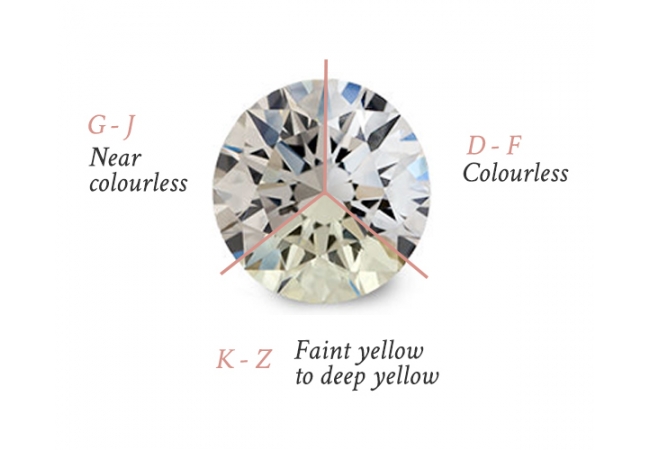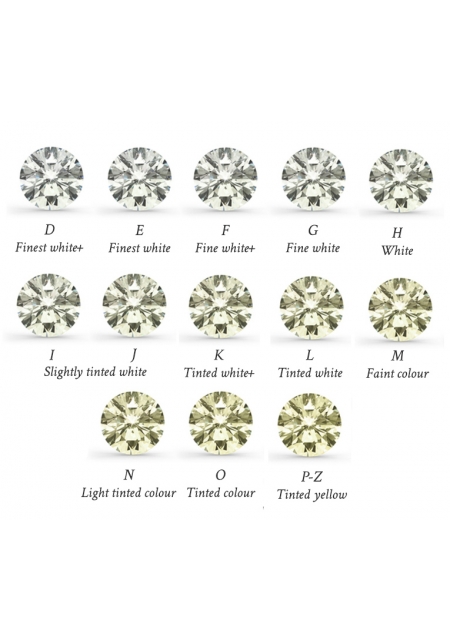9 Minute Read
Diamond Colour Guide
When it comes to picking the perfect diamond, there are a number of important factors to consider – and choosing the right diamond colour is just one of them.
From carats to clarity, it can be difficult to know where to start with so many different options to contemplate, but with some careful consideration and insider know-how, finding your ideal diamond couldn’t be easier.
In this handy guide we share our top tips for understanding diamond colour, how to identify colour in diamonds and advice on picking the colour that’s right for you – so you can feel confident that you’ve selected the perfect gem.

What is diamond colour?
The natural tint of white diamonds is commonly referred to as ‘colour’. Whilst most white diamonds typically have a slight tint of yellow, pure diamonds have no colour at all. Colour is measured on a scale that ranges from ‘colourless’ at one end to ‘light yellow’ at the other.
Colour is especially important in diamonds with a high carat number as the larger the diamond, the more easily you can see the colour. Colour is measured on a scale from D-Z, which you can find out more about further in the guide.
How colour is measured
Diamond colour evaluation is actually based on the absence of colour, rather than the presence of it. The most pure and perfect of diamonds have no hue at all, and are therefore considered more radiant and valuable as they are incredibly rare.
The amount of colour contained in a diamond is a significant determining factor to the price – to the untrained eye the differences in colour are often slight or even invisible, but these differences make a big impact in terms of the quality, rarity and value of a diamond.
Diamond colour is usually measured by the Gemological Institute of America or ‘GIA’ colour grading system, which involves comparing the stone under controlled lighting and viewing conditions to a selection of ‘masterstones’.

The GIA Colour Scale
The industry standard scale for measuring diamond colour is known as the GIA Colour Scale, which has been developed by the Gemological Institute of America. This scale is lettered, with each letter representing the colour and therefore quality of the diamond. Most jewellers use this scale and it will be listed in the diamond certification document when you make your purchase.

Diamond Colour Buying Guide
| Grade | Ideal For | Cost | Top tips |
|---|---|---|---|
D-F Icy, colourless diamonds | White gold or platinum settings Oval and Marquise diamond shapes Ring sizes over 1 carat | Most expensive | Very Subtle difference between D-F unless you’re an expert! |
G-J Near colourless diamonds | White gold or platinum settings Emerald and Asscher diamond shapes Ring sizes over 1 carat | Still expensive but roughly 10-20% cheaper than a ‘D’ diamond | Not much difference to D-F apart from on very close inspection. H is often considered the cut-off point between luxury colourless and slightly tinted |
| K-M Faintly coloured diamonds | Yellow or rose gold settings Round or Princess diamond shapes Ring sizes under 1 carat | More affordable, roughly 20-30% cheaper than a ‘D’ diamond | Slight yellow/brown tint to the naked eye, more obvious from underside. Some jewellers will not carry anything below this bracket but in the right setting, K-M can still look great |
N-R More strongly coloured diamonds | Yellow, rose gold or other coloured settings Round or Princess diamond shapes Ring sizes under 1 carat | Affordable, roughly 30-40% cheaper than a ‘D’ diamond | Noticeable yellow/brown tint, would need a colourful setting and simple shape to look more expensive |
S-Z Most strongly coloured diamonds outside of the ‘fancy’ diamonds category | Less traditional diamond pieces, coloured metal settings Round or Princess diamond shapes Ring sizes under 1 carat | Most affordable, roughly 40-50% cheaper than ‘D’ diamonds | Very noticeable tint, often deliberately chosen for colour |
Top Tips To Remember:
- Diamond colour becomes harder to distinguish once the stone is set and is in a non-white background
- Most people cannot distinguish colour grades of diamonds unless they are carefully studied in a controlled environment or they are compared side by side
- Colour is more important in bigger diamonds, as it is easier to perceive
- Buying a ring should be a balance of all factors including colour, clarity, cut, carat weight and more. For the best purchase, balance your budget across all of these factors – for example choosing a J colour grade may allow you to afford a higher clarity or weight of diamond as well, and therefore on balance a better ring overall, rather than choosing a D grade diamond but only being able to afford a very low clarity or carat
- When buying a specific diamond, if you are given a range (such as G-H) by a sales assistant rather than one specific letter, then the diamond may not be certified by the GIA and the seller is simply estimating the colour using the scale. When buying the diamond, you should always request to see the GIA certificate so you know what you are investing in
- If your ideal ring contains a large diamond set amongst smaller ones, opt for colour grade D-J for the larger diamond, as being surrounded by small ones can make it look tinted
- When shopping for rings with multiple diamonds, the ideal scenario is to either match the colour grade of any smaller diamonds to the main diamond, or to use a slightly darker shade for the smaller diamonds to draw attention to the main one
Frequently Asked Questions
Got a question about diamond colour? Here's some FAQ's to help.
You might think it pretty normal to describe any type of diamond as ‘fancy’ – but in actual fact, only 1 in every 10,000 diamonds is a true ‘fancy diamond’. Fancy diamonds are coloured diamonds that appear in a range of hues including orange, bright yellow, blue, green, pink and red.
Fancy diamonds are not given a colour rating because their colours fall outside the GIA scale. They are often the rarest and most valuable diamonds you can buy.
Did you know – true red diamonds are the rarest of all, with only 20-30 known to exist
Determining what is the ‘best’ diamond colour is subjective, and really comes down to personal preference. Colour is just one key factor you should take into consideration when buying diamonds, along with all the other elements of the piece of jewellery you are buying.
The metal used for setting, the shape of the diamond, the clarity of the diamond, along with several other factors, will all affect the final appearance of the item. A colour that might work really well for one piece may not work as well for another that uses different metals or shapes. Whilst colourless diamonds are typically considered to be the most valuable, the tone of the ring’s setting can affect how the diamond looks, and you may actually prefer a diamond with a slight tint of yellow if your gem is set in a yellow or rose gold band.
Alternatively, if you’re opting for a white metal like platinum, a whiter or more colourless diamond may suit this type of metal setting better. Another thing to consider is your budget – to most people, a slightly more yellow tinted diamond will look almost, if not completely, identical to a colourless one, and will be much more affordable. You could potentially save yourself as much as thousands of pounds, for a ring that looks basically the same.
However, if you’re looking for the absolute best that money can buy, with the most sparkle and ‘pizazz’, then a colourless or fancy diamond is the way to go as these are much more rare, and therefore valuable.
Generally, most people tend to opt for a grade ‘G’ or ‘H’ diamond. These diamonds tend to be a bit more affordable, but also don’t really show visible signs of colour or yellow tint to the naked eye.
In some ways, yes - diamond shapes can affect the overall look of the piece, including the colour. Rounder diamond shapes have more facets and a lot of their own sparkle, so can more easily carry yellow-tinted diamonds and still look expensive.
However oval or marquise diamonds are shaped in such a way that the colour of the diamond may be more obvious, and so choosing a higher grade colourless diamond may be a better option.
The reason the scale starts at ‘D’ is because when the GIA set it up, they wanted to distinguish their scale from all other A-Z scales or numerical scales that already existed.
This fresh scale could then be used by jewellers as an industry standard, without any confusion. As a lot of varying other diamond scales already existed, causing a lack of clarity for buyers and a lack of standardisation for jewellers; this new GIA system starting with ‘D’ is now the most universally used.
Still need help?
If you need any further assistance and guidance with diamond colour, our jewellery experts are here to help! Visit us in store or call us to arrange an appointment so we can provide the guidance you need. You can also send a message via zendesk in the bottom right of your screen.
Libby Johnson
Director, Johnsons Jewellers




